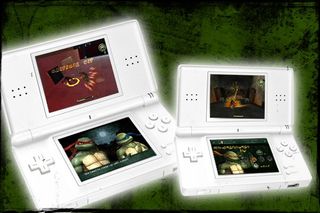GamesRadar+ Verdict
Pros
- +
Remembering good TMNT games
- +
Renting instead of buying
- +
Finishing this game
Cons
- -
The platforming
- -
The fighting
- -
That there's nothing to love
Why you can trust GamesRadar+
Imagine an action game with three different buttons for jump, but a camera which often made it difficult to tell which one to use at any given time. Imagine an action game with one attack button that triggers one three-hit combo... one. Imagine a game with turtles as its stars - but they almost never run. Instead, they must jump nearly everywhere they go, leaping only from one designated launching point to that launching point's specific landing spot - dot-to-dotting over the landscape like obsessive-compulsive, routine-obsessed frogs. Imagine a game with four ass-whupping main characters, but you still only play as one at a time, with the others only occasionally joining in for a single special attack or to race you through a level. And then be amazed, bewildered and heartbroken that such a game exists: it's TMNT - in other words, Teenage Mutant Ninja Turtles - for DS.

How does this happen? How does one of the most beloved beat 'em-up franchises in gaming history turn into a game where it's difficult to even move? In case you still don't have a clear mental picture of this mess, we'll explain further. Let's say you're running across a rooftop and want to leap to another one. You can't just press a button marked "jump" and push the controls in the direction you want to go. Instead, you look for a white light on the ground, and when you're close to it, start watching for a blue (or orange) flash somewhere around your destination.
When you get to the white light, you press X to leap forward, Y to jump left, or A to vault right - depending upon where the blue/orange light is. When you land on a blue light, you're done, the jump is completed and you can start looking for a new location to jump to. If you land on an orange spot - say, a pole, a slope, or a fence rail, you have to hold down B to charge your momentum by sliding, spinning, or just hanging there until the orange becomes blue. When it does, you can release and continue on your way.
More info
| Genre | Action |
| Description | Urgh. Devoted young fans may flock to this weak imitation of publisher Ubisoft's own Prince of Persia games, but more discerning players will quickly pull their heads inside their shells and move on. |
| Platform | "GameCube","Xbox 360","Wii","PS3","PC","Xbox","PS2","PSP","DS" |
| US censor rating | "Everyone 10+","Everyone 10+","Everyone 10+","Everyone 10+","Everyone 10+","Everyone 10+","Everyone 10+","Everyone 10+","Everyone 10+" |
| UK censor rating | "","","","","","","","","" |
| Release date | 1 January 1970 (US), 1 January 1970 (UK) |
Most Popular


